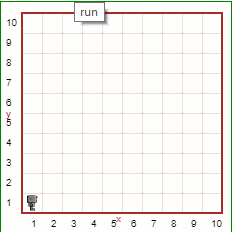Maze construction algorithm
Mazes are constructed using a depth-first search algorithm adapted from http://rosettacode.org/wiki/Maze_generation; using this algorithm results in a simply connected maze, one without any loops or closed circuits, and without any inaccessible areas; this type of maze is sometimes called a "perfect maze". We can show how a maze is constructed by using the "recording" option.
think(100) # speeding up from default value of 300 ms
RUR.create_maze(10, 10,
{"small_tiles": True,
"recording": True})

First, the world is emptied of all its content and its size is adjusted based on the first two arguments of RUR.create_maze(); then, walls are added everywhere possible; they are then removed one by one using a depth-first search algorithm.
To illustrate better the algorithm, we can use colors; a default palette, subject to change, has been used in the illustration below:
think(100)
RUR.create_maze(10, 10,
{"small_tiles": True,
"recording": True,
"use_colors": True})

With a world filled with walls:
- We pick a random cell as our starting point; this is the green square.
- From our current location:
- we pick a neighbouring cell at random, but one that has not been visited; this cell is shown in red
- we remove the wall between these two cells., and add the neighbour to the list of visited cells; the previously visited cell is now colored yellow.
- we go back to i. until we end up with a cell without any unvisited neighbours; in this case we backtrack to a previous cell that has at least one unvisited neighbour (leaving the "dead end" cell red).
- we repeat this process until there are no unvisited cell.
There is an additional color choice made above, having nothing to do with the algorithm: when a cell can be reached from three neighbours without walls blocking the way, it is colored in grey; if a cell could be reached by its four neighbours, a different color would be used.
[warning] Creating your own version
If you try to implement your own version of this algorithm using Python, you may find that the display will appear to be frozen for a relatively long time as the maze is created.